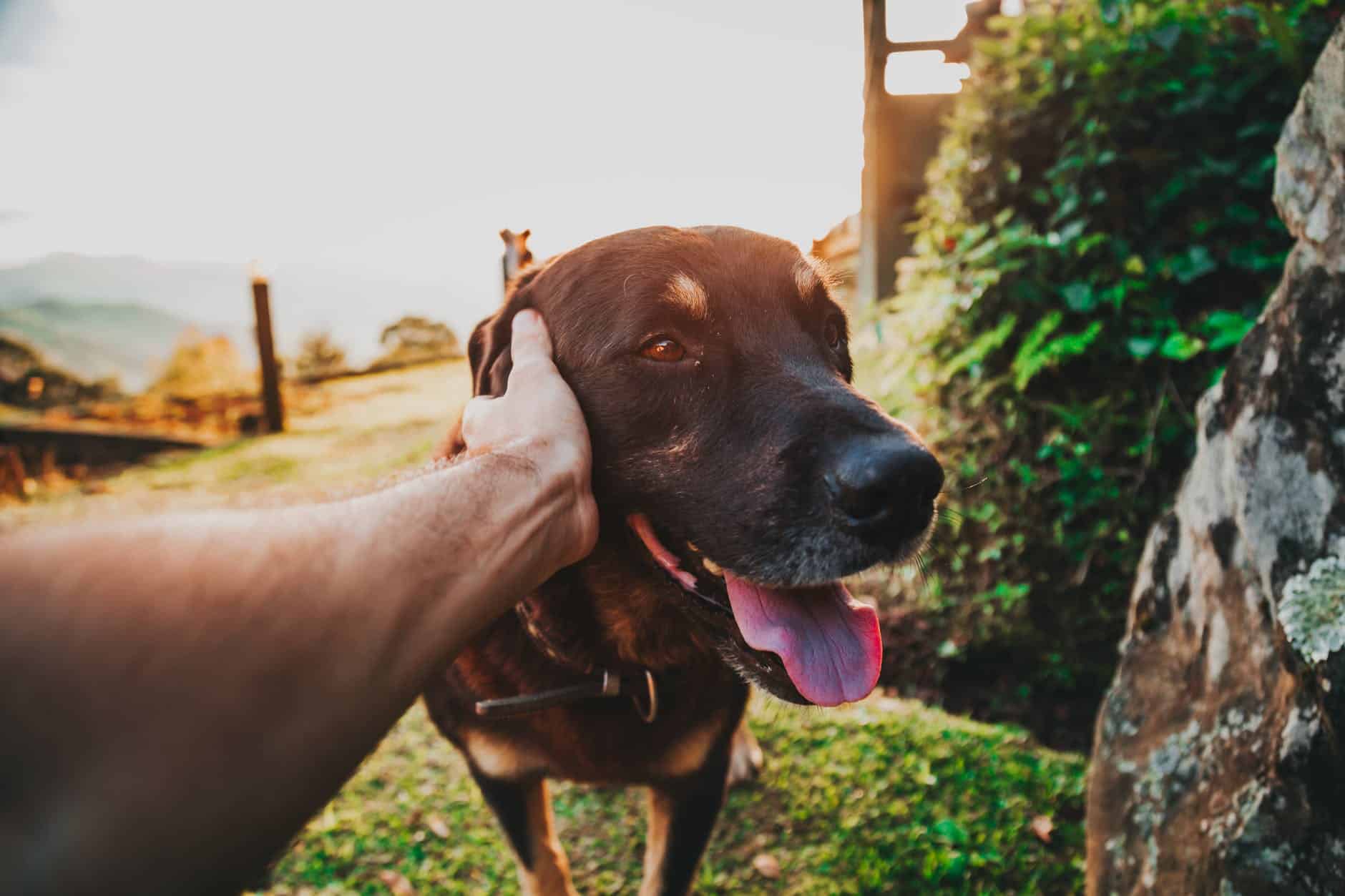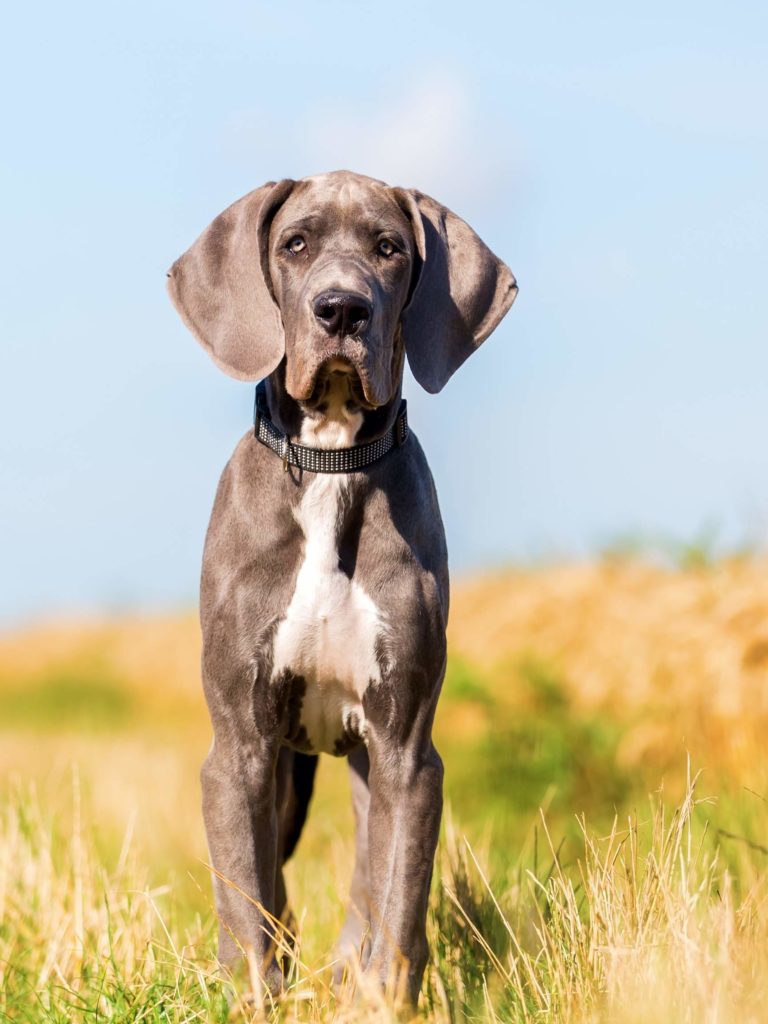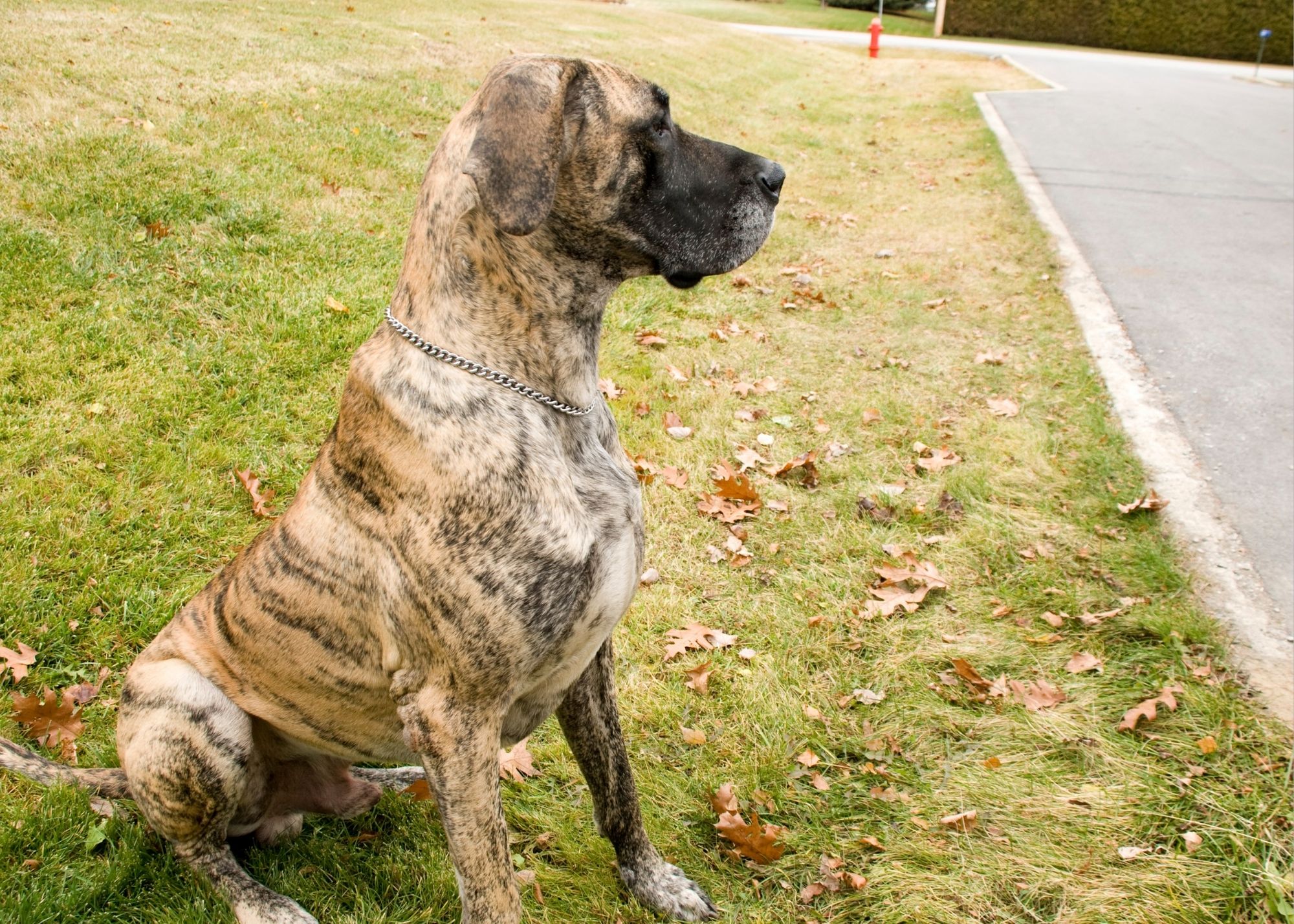A lot of people are intimidated by Great Danes because they are so large. There is this assumption that Great Danes are aggressive, perhaps because they are large and generally protective. To make matters worse, many landlords and leasing companies, as well as homeowners insurance companies will list Great Danes as a restricted or ‘aggressive’ breed.
So, are Great Danes aggressive? Do Great Danes make good family dogs? Are Great Danes good for protection work?
We are going to look first at the actual written breed standard.
Great Danes & Aggression
The written breed standard from the GDCA states:
The Great Dane must be spirited, courageous, always friendly and dependable, and never timid or aggressive.
Intelligence, loyalty and dependability are true breed characteristics. Timidity and aggressiveness are alien traits and should be severely penalized.
Basically put, Great Danes are NOT supposed to be aggressive or timid.

WHAT CAUSES AGGRESSION IN GREAT DANES?
Just because Great Danes are not supposed to be aggressive, doesn’t mean that they never develop it. There are many factors that contribute to temperament problems in Great Danes.
- Breeders that breed poorly tempered dogs
- Unethical and unhealthy breeding practices
- Poor early experiences in the litter
- Puppy mills & backyard breeders
- Nutrition issues, including malnutrition
- Genetics
- Health problems, including thyroid disease, dysplasia, poor eyesight, cancer, overgrown nails, bad teeth, arthritis, hormones, etc.
- Training practices that employ intimidation, fear or pain, including alpha rolls
- Poor socialization and poor early social experiences, lack of training
The tragic part here is that nearly every single one of those circumstances is preventable through thoughtful breeding practices, educated ownership, positive socialization and appropriate training.
Aggression, resource guarding, leash reactivity and nipping at children are major reasons that Great Danes are surrendered to rescue.
PUPPIES vs. RESCUE
Many people choose a breeder over a rescue because they want to raise the puppy ‘their way’ and make sure it isn’t ‘aggressive’, which is an interesting thought. It comes with one major stipulation, however.
Bad breeders are everywhere and they are creating thousands of fearful puppies that develop reactivity and aggression.
These breeders are not health testing their dogs, they don’t understand genetics, they allow puppies to go home prior to 8 weeks of age, they aren’t keeping the puppies in a clean or healthy environment, and they aren’t properly socializing the puppies before they go to their homes.
So many temperament problems could be greatly reduced in Great Danes if we all made the effort to only support breeders that truly care about health, temperament and structure.
Dogs from rescue and dogs from breeders can have amazing temperaments, or they can be aggressive and unpredictable. If you absolutely need a dog with an outstanding temperament, choose a rescue with a well-known and well-tested personality, or choose a highly ethical breeder with fully tested, proven lines and a thoughtful socialization program.
HEALTH & HORMONES
Spay and neuter are often advertised as the solution to behavior problems. While removing those hormones may help, it is unlikely to eliminate aggressive behaviors.
There are many other health problems that can lead to snapping, growling and aggression.
Just like humans, dogs can have mental health conditions that may be treatable with prescription medications.
Painful health problems such as hip dysplasia, overgrown nails, growths, and even cancer can cause a dog to have a short temper.
Thyroid disease or even eyesight and hearing problems can also present first as aggression.
If your Great Dane has become aggressive suddenly or over time, we highly recommend that the first step, in tandem with the help of a highly qualified, credentialed behaviorist be a thorough and complete vet check. A blood panel should include screening for diabetes and thyroid disease. The heart, hips and eyes should also be evaluated.
A note on ‘BE THE BOSS’
Many people believe (perhaps because they were taught this from reality TV star Cesar Milan) that the solution to all aggression is to ‘Be the boss’ and ultimately lead with some form of intimidation (physical or emotional).
An aggressive dog that is met with such a challenge may actually become more aggressive…and dangerously so.
Science tells us that aggression is not related to pack hierarchy as previously thought. Find a qualified trainer or behaviorist to help you.
The biggest problem with a blanket approach to aggression of ‘be the boss’ or ‘be the alpha’ is that it fails to take into account the many reasons a Great Dane may be aggressive: fear, pain, hormones, undiagnosed medical problems, lack of mental and physical enrichment or mental health issues.
Calm, benevolent leadership, training, management, enrichment and respect are needed. Not intimidation, isolation and a power struggle.
GREAT DANES & CHILDREN
Great Danes that are well socialized, trained and raised around children make wonderful family dogs!
Puppies do bite and nip as a form of play, and they do require a lot of guidance and training.
The majority of real bites to children happen from known family dogs, and often ‘out of the blue’.
Children should never:
- Scold, pinch, shout, hit or scream at dogs
- Chase, corner or pin dogs
- Ride, bounce, lay or sit on dogs
- Bug dogs when they are sleeping
- Take their food, toys or bones
Proper socialization of Great Danes around children means teaching them to be calm around children (go to a mat, sit near them, no jumping) and teaching them that children are positive, fun and great to be around. Manage your puppy so that jumping, nipping and chasing children are not behaviors that are practiced.
A well socialized Great Dane has a much higher tolerance for those times when a child (or even an adult) does something rude, scary or annoying.
GREAT DANES PROTECTIVENESS
At their core, Great Danes are still working dogs. They have protective tendencies.
Do not mistake fear and aggression with protection! A fearful or aggressive dog will hide, growl, snarl and even snap, lunge or bite. Those behaviors are NOT necessarily protective or appropriate.
A protective Dane may bark as a form of alert, but will be able to move on if threat is determined safe.
They act out of protection, not blanket fear or frustration towards dogs and people.
NOTE: This is very different than Danes that are trained in actual bite and protection work.
Great Danes that are prone to contact (biting, nipping) should be considered dangerous, and muzzle training, strict management and working with a highly qualified trainer is highly encouraged.
Dogs that are trained to bite on command (bite work/Schutzhund) are dogs with excellent impulse control and obedience, not dogs that are aggressive, fearful, confused, under-enriched or out of control.
RESCUE AND ABUSE
Some Great Danes in rescue may be aggressive because they come from an abusive or difficult background.
It’s important, however, to never assume that all aggressive or fearful rescue Danes were abused.
They may simply be the result of poor breeding practices and improper socialization and training.
They may be fearful of men, for example, but that doesn’t always mean they were abused by men.
Many rescue Danes just need a chance to build trust and to be respected and appreciated; they open up and can become wonderful, friendly, safe and happy family pets.
We encourage all Great Dane owners and breeders to support rescue through volunteering, donations, advocacy, education and adoption. You may never choose adopt a Great Dane, but even a small donation to their operating expenses is a meaningful way to support Great Danes.
DO YOU HAVE AN AGGRESSIVE GREAT DANE?
If you are struggling with a Great Dane that is nipping, lunging, growling and even biting it is extremely important to follow these steps:
- Use management tools to prevent the behavior: space, time, crates, muzzles & leashes.
- Create a journal and document the body language leading up to the aggression, as well as the situation and reaction that happened.
- Have your dog thoroughly checked by a veterinarian (blood panel at minimum).
- Seek out the help of a highly qualified trainer with behavior credentials, or a Board Certified Veterinary Behaviorist.





